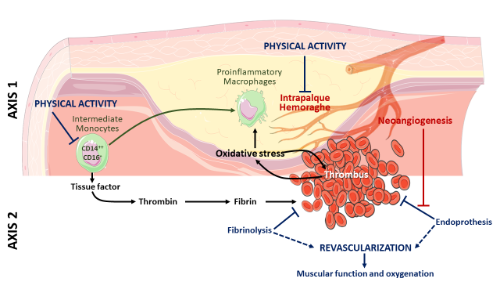ATPA PROJECT
General design of the scientific project of the ATPA team.

1. Understanding the effects of physical activity on the prothrombotic risk and the risks of instability of carotid plaque.
Epidemiological approach
Physical activity and sedentary behavior will be assessed by questionnaire in prospective epidemiological studies piloted at local level by the Service of Vascular and Endovascular Surgery of the Academic Hospital of Lyon (ESCT2 and ACABII). This epidemiological approach will allow us to evaluate the prospective effect of physical activity and sedentary lifestyle in patients with high risk of ischemic and thromboembolic events. PI: Pr A Millon.
Clinical approach
As mentioned above, we have previously shown in a cross-sectional study that the prevalence of carotid intraplaque hemorrhage - a major factor in plaque instability - erythrocytes hyper-aggregation and the percentage of intermediate monocytes, were decreased in the physically active patients (Mury et al, 2019; Mura et al, 2019; Mury et al, 2017). In addition, the structural characteristics of the thrombus and the consequences on ischemic risk could be modulated by physical activity (Kumar et al, 2011). In this first project, the impact of a physical activity intervention in ecological conditions will be tested on the various parameters: risk factors of the carotid plaque instability (intraplaque hemorrhage, neovascularization, fibrous cap) measured by MRI, phenotype of circulating monocytes, structural/ultrastructural characteristics and kinetics of venous blood clot formation, rheology of red blood cells, oxidative stress, physical fitness and quality of life in patients with unfavorable benefit/risk ratio of endarterectomy. This physical activity intervention in ecological conditions has been already validated by our team on a cohort of patients with metastatic breast cancer in using connected activity bracelets (Delrieu et al, 2019, in JMIR). PIs: Pr V Pialoux & Pr A Millon.
Fundamental approaches
We also aim to understand how physical activity and sedentary lifestyles modulate the phenotype (see the review from Aw et al, 2018) and the function of monocytes (release of pro and anti-inflammatory cytokines and chemokines, phagocytic phenotype). For that purpose, proteomics techniques, multiplex on carotid artery plaque and plasma of active or sedentary patients and in vitro culture of monocytes will be used. PIs: Pr V Pialoux & Pr A Millon.
It has been suggested that the phenotype of circulating monocytes may modulate the risk of venous thrombosis (Thaler et al, 2018). To answer this question in patients at risk of ischemic stroke (carotid stenosis > 50%), in vitro approaches recombining activated monocytes (artificially or from patients) in the blood of healthy subjects will be performed. For this purpose, structural/ultrastructural characterization and kinetics of venous blood clot will be used. PIs: Dr C Faes & Pr V Pialoux.
Based on our previous results showing that physical activity decreases the percentage of intermediate monocyte (Mura et al, 2019) and that this type of monocytes expresses more tissue factor (Thaler et al, 2018), we will investigate molecular and cellular mechanisms, including monocytes tissue factor expression and coagulation parameters. In particular, structural and kinetics formation of ex vivo venous blood clot in response to physical activity in these patients will be studied. PIs: Pr V Pialoux & Dr C Faes.
2. Optimization of surgical and pharmacological revascularization treatments
2.1. Type 2 endoleaks and neoangiogenesis
It has been proposed that the hypoxic signal and neovascularization could be at the origin of the non-mechanical failures of abdominal aneurysm surgery, called the type 2 endoleak (Della Schiava et al, submitted). Importantly, the redox and pro-inflammatory environments of the aneurysm clot could be involved in the activation of these hypoxic and angiogenic signals (Görlach et al, 2008; Chandel et al, 2000).
Epidemiological approach
Anatomical characteristics of Type 2 endoleaks will be studied in a retrospective epidemiological study, based on the data from the last 5 years of abdominal aneurysm surgeries done in the Service of Vascular and Endovascular Surgery of the Academic Hospital of Lyon (n=800). PI: Pr A Millon.
Clinical approach
In this project, the roles of redox and inflammatory status, hypoxic signal, neoangiogenesis and histological properties of thrombi as well as their dynamic formation on the risk of type 2 endoleaks after surgery of abdominal aneurysm will be evaluated. The effect of pharmacological anti-VEGF treatment on the prevalence of type 2 endoleaks will then be tested. PI: Dr C Faes and Pr P Lermusiaux.
Mechanistic approach
To answer the question of the effect of the endoprosthesis per se and its optimization on the risk of thrombosis, the formation of ex vivo venous blood clot around vascular prostheses will be measured by microfluidic dielectric coagulometry. This will allow to identify an appropriate surface treatment to limit the highly thrombogenic properties of dacron and polyetrafluoroethlyene (PTFE) surfaces. PIs: Pr P Lermusiaux & Dr C Faes.
2.2. Fibrinolysis
One of the major parameters that affects fibrinolysis is the composition of the thrombus. The composition is itself influenced by the age of the thrombus (Silvain et al, 2011) as well as by its origin (arterial, venous, coronary, cerebral) (Sadowski et al, 2014; Sato et al, 2012; Silvain et al, 2011). In view of these differences, the response to fibrinolytic treatments is different and therefore affects the revascularization and consequently the duration of ischemia. The characterization of the structure of the clot should optimize the type and duration of treatment. The effects of the structure/ultrastructure, i.e. the physical and mechanical properties of arterial thrombi in the lower limbs (by in and ex vivo approaches), on the duration of fibrinolysis will be analyzed via urokinase treatment. The time until revascularization (doppler), the levels of oxygenation (NIRS) and muscle function of the lower limbs will be measured. One of the specificities of this project is the association of biologists, physiologists, radiologists and physicists. PIs: Dr C Faes & Pr A Long.


